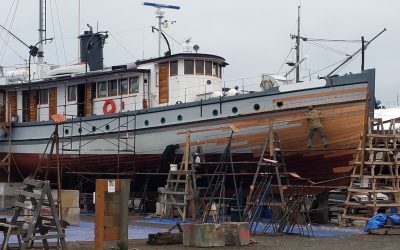Westward’s Big Boatyard Adventures Part IV

Like any major project this one continued to grow and morph until the final accounting of what was done has only a superficial similarity to what was originally planned. The sole reliable element is that it will take longer and cost more than anyone, regardless of their experience and background, has predicted. Some of these changes were because the scope of the project had expanded, some because it took longer than expected to accomplish anticipated tasks, and some because some grant writer has found the funding to re-plank their museums’ 150’ hulk and has thus absorbed the entire west coasts’ stock of clear fir planking stock, thus making what remained very valuable. The budget could collapse because a major contractor “forgot” to include sales tax in his estimate, thus tilling the soil for a 13% overrun in his particular line item with no changes in materials or labor costs!
Of course, the fact that I had miraculously found enough money to cover the original projected costs to get Westward rebuilt, refit, filled with fuel and provisioned for her winter Baja season doesn’t automatically mean that I could find a hypothetical 13% (or 5% for that matter) more. Going back to my various lenders and patrons with empty wallet held forth as a communicant offers a trembling tongue is not a pleasing scenario.
But, as things stood about one third of the way through the project, the budget and schedule were both intact.
We began the excavation into Westward in late June, 2015, and had a departure date for the Sea of Cortez in late November. Our first charter of the winter season was scheduled to sail from La Paz on December 30th, and it was impossible to predict how many weather days I would need to include for the fifteen hundred mile run down the west coast. Doubling my estimated straight through travel time of fourteen days seemed reasonable, plus a day in San Diego to fuel up on cheap US fuel before we got into Pemex-monopoly land, and another in Ensenada for Mexican customs clearance puts me at thirty days from Port Townsend to La Paz.
If we arrive early then there are decks and cabin sides to paint, paddle boards that need wetting, and taunt pale backs that need exposing to the sun.
Considering all of these factors, I had a total calendar of twenty-one weeks. At the beginning of week six, we were just short of one third of the way through of our schedule allowance. The budget for the hull work is $230,000, and I had already borrowed and paid $100,000.
The abbreviated hull work accomplished as of mid-August consists of;
- Remove all compromised wood and fastenings.
- Straighten the keel, lift the sagging bow (which is out of alignment by about 8”)
- Remove the existing lower interior and decking, remove the existing water tanks.
- Remove garboards and broad strakes to provide access to the keel and floor timbers.
Budgeted work needing to be done before we sail for Mexico in November includes:
- Replace the much bandaged keel timber.
- Install proper blocking at the keel/frame/keelson connections
- Install floor timbers, which were either never installed, or were removed to create room for water tankage.
- Replace all keel and frame drifted fastenings with through bolts.
- Install new garboard and other removed bottom planks
- Replace all damaged frames and blocking in the bow section.
- Replace about 48 planks in the bow.
- Cork and fill all opened seams.
- Replace framing for the lower cabin soles.
- Install a new diagonal timber to reinforce the hull in the vicinity of the original “kink”.
Not in the budget, but hopefully allowed for in the schedule were:
- Modify the existing stainless steel water tanks to provide access to the bilges and keel bolts.
- Install new T&G fir cabin soles.
- Install all new black and grey water plumbing.
- Design and build new guest accommodations in the lower cabin area.
- Paint the bottom, topsides and new interior.
- Install new lighting and electrical receptacles in the guest cabins.
- Divide an existing deck level storage locker into more efficient storage space and head compartments.
- Replace the rotten foremast
- Build outriggers for the deployment of our passive stabilizers (for use at anchor)
- Pay the yard bill.
As the work moved forward into September, 2015 we began to experience the expected schedule creep. I decided in mid-November that we weren’t going to make it to La Paz on time to run the charters we had already booked, so, for the first time since buying the company in 2005, I cancelled a trip.
